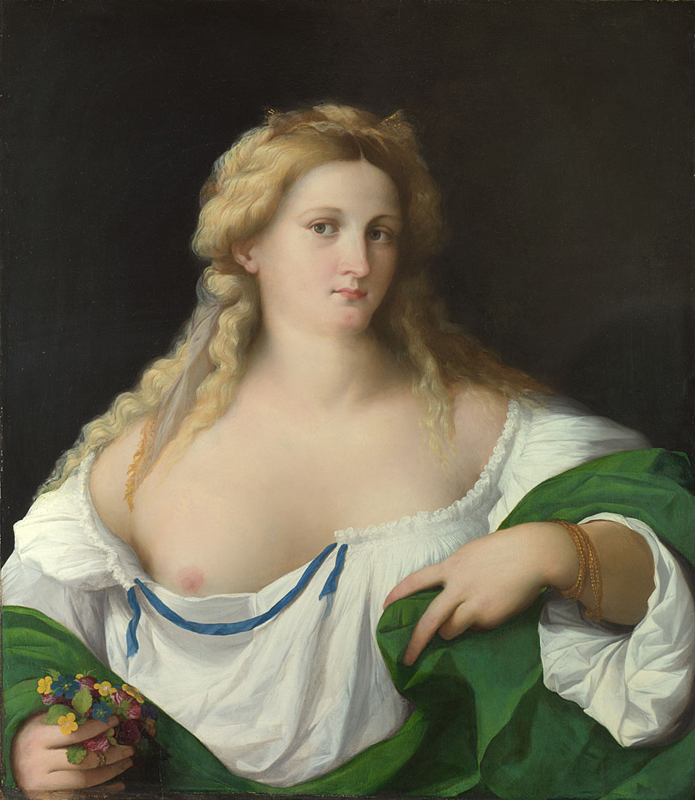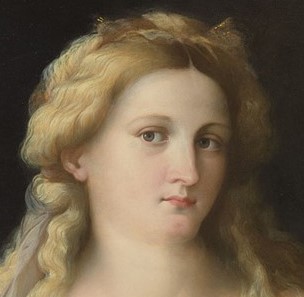
Palma Vecchio, A Blonde Woman, 1520, National Gallery
Flora the ambitious blonde? Well, yes. Palma Vecchio’s A Blonde Woman is most certainly blonde. But where does ‘Flora’ come in? And why might we say that this lady has ambition?
Read on!
Firstly, that is a knowing gaze. Also, because her eyes are sliding off to the left, our eye is drawn to the gorgeous pink nipple first and then to the posy of flowers. Before we get onto the flowers, I need to linger on the nipple and the breast (!) because, whoops, does she even know that her pretty blue ribbon has come undone? Or that the loop of the ribbon against this again rather soft and sensual abundance of white chemise perfectly frames her perfectly pert right bosom?
And so to the flowers. Firstly, isn’t it gorgeous the way that the colours echo the gold of her hair and jewellery, her ribbon and the green of her dress and of course the rosy pink of her nipple. They also may have symbolic meaning. The forget-me-nots ask us to do what they say on the tin, buttercups are all about dazzling charms and the primrose (pink flower) associated with first love ‘prima rosa’ because they flower in early spring.
It doesn’t take Sherlock Holmes to figure out that perhaps this unapologetically erotic portrait is of a courtesan. But if you were in any doubt, let’s delve deeper into the clues, starting with the gaze. No up standing member of the 16th century community is going to sit around for hours on end with her chemise undone and slipping off her shoulder to expose a boob. And they are definitely not going to look invitingly at you as they do it!

The posy of flowers, however, is fairly innocent, right? Wrong! The flowers allude to the goddess Flora which in itself is lovely. Classical antiquity was all the rage in the 1520s and to depict a goddess showed a certain erudition. But Flora, ah! Flora was the goddess of the flowering or blossoming of flowers and plants, especially agricultural crops. Violently abducted by Zephyr the west wind , she was subsequently given a beautiful garden. So she is the goddess that makes things grow, by which I mean ‘things’ other than flowers and crops. We can thank ancient Rome for that bit of double entendre. Courtesans in the Renaissance era were commonly called Flora as a result of this. And just another connection to antiquity; all prostitutes in ancient Rome had to have blonde hair. Do we think she’s a natural blonde? Unlikely!
There was, in the 16th century, a fashion for Venetian women to bleach their hair. This 16th century version of sun-in may well have had similar results but was quite a lot more disgusting to apply and seems to have involved pigeon shit rinsed off with horse urine. It’s surprising perhaps, given the smell, that bleaching the hair was a sure sign of vanity – I look good but I smell like shit (literally) – although many women apparently succumbed.

In a world in which portraits were essentially displays of wealth and the importance of lineage, why a courtesan and who commissioned this? Well, courtesans played quite an important role in 16th c Venice. There was absolutely a distinction between the honest or intellectual courtesan who often had what we would call ‘sugar daddies’ and the ladies that hung around the Rialto Bridge. The intellectual courtesans were relatively frequently not low born but born into patrician or merchant families and were, to a degree, educated. The problems started when they were at marriageable age because dowries were exorbitant. So if a couple had several daughters, they were in real danger of going bankrupt trying to marry them off. The options were that they remained spinsters and stayed at ‘home’ and then could be in the really weird position of having their baby brother’s wife as the mistress of the house; they could go into a nunnery – that also required a dowry albeit less; or they could become a courtesan which meant that they earnt a lot of money, often becoming the sole support of their family. In a society in which wealthy men often weren’t expected to marry until they were in their 30s, a cultured woman who provided entertainment and extras was almost a necessity.
‘Honest’ courtesans, as they were known straddled the gap between the noble and the lower classes but had the opportunity to mix in interesting circles and, to an extent, had power over their destiny. Those canny enough could wield considerable influence.
In sixteenth-century Venice, therefore, it wasn’t unusual for images of beautiful young women to be commissioned by collectors and the wealthy clients of courtesans. There is also evidence that successful courtesans commissioned such paintings of and for themselves, both as solid financial investments and as lasting records of their charms to be prominently displayed in their own apartments.
An ambitious blonde? Oh yes!
The video of this episode can be viewed here. To view the entire ‘Elevenses with Lynne’ archive, head to the Free Art Videos page.
